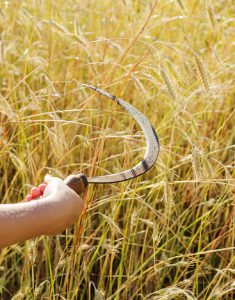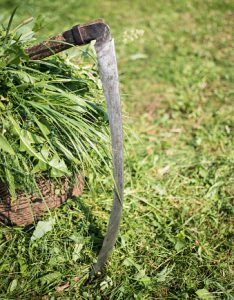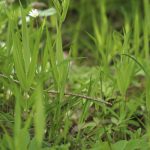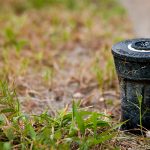More than just the preferred prop of the grim reaper, a scythe might be the dead-simple solution if you have a heavily sloped or oddly shaped yard. And you could save some storage space, too.
Call me old-fashioned, but I love a good farm tool. Living in an 800-square-foot apartment leaves me no reason to own a scythe, but that won’t stop me from having one custom-made so I can volunteer my mowing services to others.
Most people would likely recognize the scythe as the preferred prop of the grim reaper and the sickle as a symbol of communist Russia. Though considered old-school, they’re both actually helpful and efficient tools in maintaining your landscape.
 |
 |
Both have been around since the 18th century. Sickles were used for harvesting grass-like crops such as wheat and hay and mowing open areas and were later replaced by the scythe, which can be used standing up. Of course, today both have been replaced by lawnmowers and weed-eaters. While these electronic and gas-powered tools present a decreased labor cost, they do require regular upkeep, energy and are less nimble.
In fact, one of my colleagues recommends using them for maintaining wildscape grasses such as blue grama grass, curly mesquite and other tall native bunch grasses. Naturally these grasses would be maintained by wildfires. But if you live in a suburban neighborhood, your homeowner association, neighbors and local fire department may not look kindly upon you lighting it up.
Mowing tall grasses once a year in early spring (typically February) promotes healthy growth and native clumping tall grasses such as little or big bluestem need at least a 6-inch clearance when being mowed. This usually can’t be achieved using a conventional lawnmower.
Another situation in which a scythe or sickle may benefit you is if you have a heavily sloped, small, or strangely shaped yard. Conventional mowers and weed-eaters are limited in mobility, but the small blade of a sickle can get nearly anywhere. You also won’t need as much storage space as you would for a lawn mower or weed eater, as sickles and scythes easily hang flat on the wall.
Finally, if you’re dealing with an area that is heavily covered in weeds from neglect, a conventional electric mower would disperse seeds. With a sickle, you could ‘harvest’ the weeds without spreading them and making the weeds worse. It’s also means less work pulling and more focused cutting.
Considering trading your lawnmower for a sickle or scythe? Scythe Supply has lots of informative articles including one on how to choose to your scythe. And this video demonstrates how to mow correctly using a scythe.



